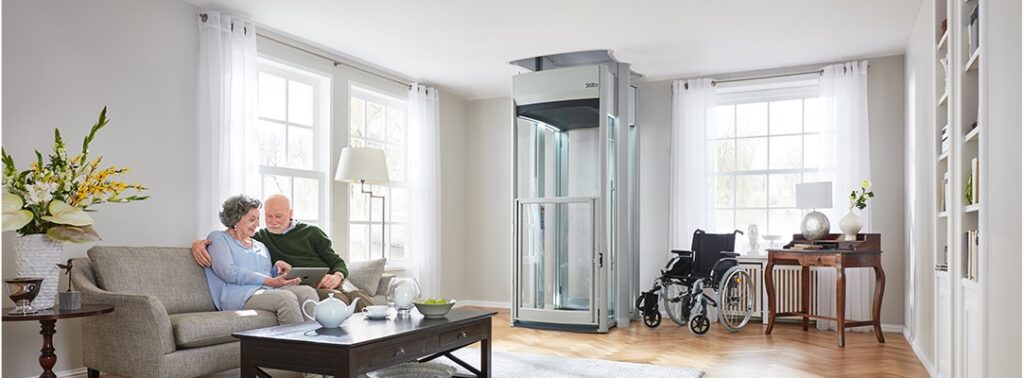Learn the difference between hydraulic, traction, and non-hydraulic home lifts with Stiltz.
Traction Lifts vs Hydraulic And Non-Hydraulic Home Lifts: Which is Better?

Traction Lifts vs Hydraulic And Non-Hydraulic Home Lifts: Which is Better?
A home lift is a great way to regain full access to your home if you’re among the 45% of older adults who find using the stairs challenging. But, with so many options on the market, knowing which is right for you can feel overwhelming. You may have come across terms like hydraulic lift, traction lift, and non-hydraulic lift — but what do they mean?
In this guide, we’ll explain how each type of domestic elevator works and their key differences to help you decide which lift suits your needs.

What is a hydraulic home lift?
Hydraulic home lifts use fluid pressure to move the car up and down. Instead of a traditional counterweight system, an electrically powered pump pushes hydraulic fluid into a cylinder, which then moves a piston to raise or lower the car.
These lifts don’t need an overhead hoist, so they’re a common choice for properties with lower ceilings. However, if you’re thinking about installing a hydraulic lift for your home, you’ll need to factor in their installation requirements, from creating a separate machine room for the hydraulic pump to fitting a shaft for the lift to travel through, both of which can cause a lot of disruption.
Hydraulic lifts rely on a pump system, so they need additional space to store the pump unit — often in a cupboard or purpose-built machine room. This can make them more challenging to fit into your home’s layout and add extra time to the installation.
What is a traction home lift?
A traction home lift uses a complex system of steel ropes and pulleys that are looped around grooved wheels (sheaves) to move the car in either direction. Unlike hydraulic lifts, they rely on a counterweight system to balance out the lift and keep it upright while it’s in motion. This makes them smoother to use and more energy-efficient.
There are two main types of traction lifts:
- Geared traction lifts — These use an electric motor with a gearbox to control their movement. They’re usually found in tall buildings where lifts need to travel longer distances.
- Gearless traction lifts — These models don’t have a gearbox and use a more advanced motor system, making them quieter, faster, and more energy-efficient across a short distance.
As traction lifts don’t need a separate pump unit like hydraulic models, they take up slightly less space. However, they require a dedicated lift shaft directly between floors to house the pulleys and counterweights. This can make the installation more challenging, as structural engineers are required to make sure the shaft doesn’t compromise the building. This also leaves more of the lift mechanism on show, making it harder to blend into your decor.
What is a non-hydraulic home lift?
A non-hydraulic home lift is a simpler way to move between floors without needing complex structural changes or bulky machinery.
Unlike hydraulic lifts, which rely on fluid pressure, non-hydraulic lifts are powered by a self-contained drum-braked gear motor stored in the roof of the car. This motor rotates to raise and lower the car on a set of free-standing tracks using steel cables, rather than a shaft, which allows it to run smoothly and quietly.
At Stiltz, our non-hydraulic domestic lifts were one of the first on the market. They don’t need a machine room or a load-bearing wall, making them one of the most flexible options to help you age in place. Instead, they use a self-supporting dual rail system, which can be placed in various locations — from garages to unused cupboards.
This also means they’re easy to install, with no major structural changes, and equally simple to remove if they’re no longer needed. Plus, with one of the smallest footprints of any domestic lift, they’re unintrusive and perfect for slotting into empty spaces within your home.
6 factors to consider when choosing a home lift
When choosing between hydraulic, traction, and non-hydraulic home lift models, the best choice will depend on your home’s layout, mobility needs, and budget.
Here’s an overview of what makes each lift different:
| Hydraulic | Traction | Non-hydraulic | |
| Speed | 0.15 m/s | 0.15-4 m/s | 0.15 m/s |
| Operation | Powered by an electric pump that uses fluid pressure to move the car up and down | Uses pulleys and a counterweight to raise and lower the car through a shaft | Uses a self-contained motor to raise and lower the car on a set of rails |
| Travel distance | 3-6 metres | 3.6 metres | 4.5 metres |
| Maintenance | Serviced twice annually | Serviced twice annually | Serviced once annually |
| Cost | £23,000-28,000* | £28,000-33,000* | Start from around £16,000* |
| Installation time | 2-3 days | 1 week | 1 day (after aperture creation) |
Below, we’ve broken down six key differences to help you decide which type of home lift is the right fit for you:
1. Price
Funding a home lift is a big investment, and the installation cost can vary significantly depending on the type you choose.
- Hydraulic home lifts typically cost between £23,000-£28,000* to install.
- Traction home lifts are slightly more expensive, often ranging from £28,000-£33,000*.
- Non-hydraulic home lifts, like the Stiltz range, start from around £16,000*, making them one of the most cost-effective options on the market.
(Estimated costs sourced from Check-a-Trade).
Alongside the initial cost of having the lift fitted, the ongoing running costs can also differ. While traction lifts tend to be more energy-efficient than hydraulic models due to their counterweight system, our non-hydraulic home lifts are designed to be even more economical. They use less power than an electric kettle when ascending and even less when descending, meaning lower electricity bills.
2. Maintenance
All passenger lifts (including domestic lifts) should be serviced at least once per year to keep them in good condition and ensure they remain safe to use over time. However, certain lifts require more regular upkeep.
Due to their complex operating systems, hydraulic and traction lifts generally need servicing twice a year. Hydraulic lifts, in particular, need to be checked regularly to prevent any fluid leaks and keep them running smoothly.
On the other hand, non-hydraulic lifts have fewer moving parts, and one annual service is usually enough to keep them in good working condition. This makes them a lower-maintenance option compared to traditional lift types.
3. Installation process
The installation process is quite different for each lift type:
- Hydraulic lifts — These take several days to install and need a separate machine room to house the hydraulic pump. This means additional construction work to create the storage room, alongside cutting a hole in your ceiling and creating a dedicated elevator shaft.
- Traction lifts — These typically take around a week to install, as they require a lift shaft to be built between the floors. This involves intensive modifications to your home, like removing sections of the wall and ceiling, which need to be overseen by a structural engineer.
- Non-hydraulic lifts — These lifts offer a much simpler through-floor installation without a lift shaft or machine room. A few days before your installation, engineers will visit the site to create the ceiling aperture for the lift. Once this preparation is complete, your lift will be fitted in a single day.
4. Flexibility
Some home lift models offer more flexibility in terms of where you can install them.
Hydraulic lifts require somewhere to store the pump system, so you’ll need to factor in extra space beyond the lift itself. They also rely on load-bearing walls, which can limit your installation options. Traction lifts also come with placement restrictions, as they need a lift shaft to operate, making finding the right spot for them a bit tricky.
In contrast, non-hydraulic lifts give you much more freedom. Since they don’t need a lift shaft or load-bearing walls, they can be installed almost anywhere — whether that’s tucked into the corner of a room, inside a cupboard, or neatly placed at the end of a hallway. This makes them an excellent choice for homes with awkward layouts or limited space, giving you a lift that works for your lifestyle, not the other way around.
5. Speed
Speed might not be the first thing you think about when looking for a home lift, but it can make a big difference to your daily routine. While none of these lifts are designed for rapid travel, the way they operate affects how quickly you can move between floors.
Traction lifts tend to be the fastest, as the counterweight system makes their movement smooth and efficient — which is why you’ll often see them in commercial buildings. Depending on the manufacturer, their speed typically ranges from 0.15 to 4 metres per second (m/s). Hydraulic lifts are slightly slower because they rely on fluid being pumped in and out of a cylinder to move the lift. Most hydraulic home lifts travel at 0.15 metres per second (m/s), but you may also notice a slight delay before the lift starts moving.
Non-hydraulic home lifts are designed specifically for domestic use, offering a steady and comfortable ride. They travel at a gentle pace of around 0.15 metres per second, meaning you can get from one floor to the next in under 30 seconds. It’s just the right speed to ensure a smooth journey with no sudden jolts or jerky stops.
6. Size
Hydraulic lifts are usually more compact than traction lifts, as they don’t require an overhead hoist. However, they do need additional storage space for the pump, which creates a bigger footprint overall. This varies depending on the manufacturer, with sizes ranging from 800mm x 800mm to 1480mm x 1480mm.
Traction lifts are the largest type on the market, as they require a lift shaft. Their size can vary depending on the model, but the most compact traction lifts typically need 0.8m x 1.2m, while larger models may require up to 1.5m x 1.5m or more.
Non-hydraulic home lifts are designed to take up as little space as possible. With a unique, non-rectangular shape and a self-supporting dual rail system, they can fit neatly into a range of locations. The Stiltz Duo has a small footprint of just 0.62m², making it one of the most space-efficient options available, while our wheelchair-friendly home lift, the Stiltz Trio, offers a roomier car that’s suitable for wheelchair users. Read more about making your home wheelchair-accessible here.
For more advice on sizing, see our guide to measuring for your home lift.
Frequently asked questions
Which type of elevator is faster?
Traction lifts are generally the fastest, with speeds ranging from 0.15 to 4 metres per second (m/s) depending on the model. On the other hand, hydraulic and non-hydraulic home lifts travel at a slower rate of 0.15 metres per second, offering a smooth and gentle ride with no sudden jarring.
Which lift type is the most energy-efficient?
Non-hydraulic home lifts, like Stiltz models, are the most energy-efficient as they use the same amount of power as a standard kettle and consume even less when descending. Hydraulic lifts use the most energy, as they rely on an electric pump and generate a significant amount of heat during use.
Which home lift is best for a smaller space?
If you’re looking for the perfect option to fit a smaller space, a non-hydraulic home lift is ideal as it doesn’t require a lift shaft, counterweight, or external pump system. Stiltz home lifts have the smallest footprint on the market, with the Duo model needing just 0.55m² and the Trio model 1.25m², making them a great choice for compact homes.
Feel the difference with Stiltz
Choosing the right home lift is about more than just getting from A to B — it’s also finding a solution that makes everyday life easier.
Our industry-leading non-hydraulic home lifts are designed to be as user-friendly and efficient as possible. Both the Duo and Trio offer a smooth, quiet ride between floors, meaning you can stay in the home you love without needing to make significant changes.
Explore our full range or get in touch today — we’ll be happy to help you find the perfect fit. Or, for more advice on ageing in place, see our blog.
The prices indicated by the * are for non-Stiltz products types and as such the price is merely a guideline, for a more accurate cost you would have to contact a supplier of these products. Also, as these are estimates VAT may need to be added to them , depending on you VAT status.
Customer Testimonials
My experience with Stiltz Homelifts. Just over a month ago, I had my Stiltz lift installed and I am so pleased with it. The workmen that came and fitted it were very professional and knew what they were doing. They were so professional I would not hesitate to recommend Stiltz lifts to anybody.
Excellent from beginning to end – and beyond.
Everybody we dealt with at Stiltz was very helpful and efficient, from the initial meeting with Nick Sale, the sales rep, thorough technical inspection, the builders, installers, plumber, electrician, and excellent follow up service and attention. My husband’s life is transformed and mine is much easier. Thank you Stiltz.
An excellent company from the first contact to the completed project. All personnel were friendly and very polite but stayed extremely professional throughout. Having been in the construction industry for over 40 years I was aware the preparation work was carried out to a high standard by the best of trades people. The lift itself can not be faulted both the operation and aesthetics.
The service was better than 1st class. It was excellent in every way. We could not be more pleased with everything Stiltz applied it’s self to in any way. We would award 6 stars at the very least.
Suggested Articles
Five Reasons Why Home Lifts Are Better Than Stairlifts
Home lifts are a modern alternative to stairlifts, offering reliability, speed, capacity, and seamless aesthetic integration for a stylish and efficient solution.
How A Disabled Facilities Grant Can Help You Own A Home Lift
Disability Facilities Grants, up to £30,000, can fund home adaptations like Stiltz lifts, supporting independent living for disabled individuals.
What Happens If There Is A Power Cut And I Am In The Home Lift?
Power cuts can be unpredictable. Here’s what you need to know about using your home lift when the lights go out.






